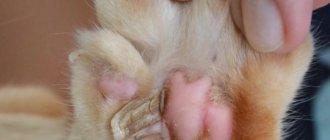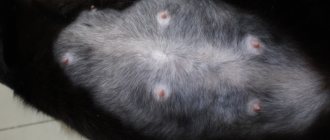— Tell me, are ticks dangerous for cats? Pauline
There are a great variety of different mites - dust mites, ear mites, scabies mites, etc. We will look at ixodid ticks - blood-sucking parasites of the arachnid class, perhaps the most dangerous representatives of this family. Yes, those same notorious carriers of encephalitis.
Where do Ixodid ticks live? It's easier to tell where they are not. And the only place they don’t exist is in Antarctica (hurray! at least there’s no one there). In general, there are more than 1000 species of ixodid ticks (about 60 in Russia), formed into six genera, three of which include spreaders of infectious diseases - ixodes (taiga tick, dog tick), dermacentor (pasture tick) and hyalomma.
Typically, ixodid ticks are active only in the warm season (from March to November). The rest of the time they are hidden in plant litter, in the roots of pasture cover, in animal dwellings, and in livestock stalls.
Ticks live in grass and shrubs at a height of up to 1 meter, preferring forest and park areas, although they can also be found on city lawns. They usually passively lie in wait for their prey, responding to thermal radiation and exhaled carbon dioxide, but some species can perform mobile searches. Ticks are most active in spring and autumn, when they are especially hungry and angry.
Of course, they pose the greatest danger to free-roaming animals, but apartment cats are not 100% protected from these creatures - there is always the possibility of bringing the parasite into the house on clothing.
What does an ixodid tick look like?
And before or after meals? After all, these are two big differences!
Externally, the tick is similar to a spider - an oval body with a small head and eight limbs. They are quite large, and females are much larger than males. The body is covered with a dense chitinous shell. In the female, the armored shield occupies only the front part of the body, allowing their digestive system and integument to stretch from several mm to one and a half cm, depending on saturation. Therefore, ticks can feed rarely (sometimes once in a lifetime), but a lot.
Their oral apparatus is equipped with a proboscis with a hypostium - on the elongated outgrowth there are sharp, posteriorly directed teeth - this is a device for piercing the skin and sucking blood. During a bite, saliva is injected into the wound, containing pain-relieving enzymes and hardening around the proboscis like cement. Thus, the tick is firmly attached to the host and can sit on it for a long time, from 3-4 days to a month. The longer a tick sits, the more difficult it is to remove it (remember the expression “clung like a tick”).
The sucked parasite increases in size, acquiring a spherical shape. A hungry tick can be dark brown, black or brown; after eating, it turns red, pink or gray. The satiated parasite falls off to rest for digestion, the female lays eggs and dies.
In their development, ixodid ticks go through the following phases: egg, larva (six-legged), nymph and, finally, adult - adult (eight-legged). Larvae and nymphs usually live on small mammals (rodents), while adults live on large domestic animals.
Tick bite in a cat: consequences
Depending on the virus that the tick infected the cat with, the state of the animal’s immunity, and how timely treatment was started, the consequences of the bite can be very different.
If the owners were able to detect and remove the parasite in time, most likely the outcome will be positive. But if the symptoms of the disease are ignored and there is no treatment, there is a high probability of the death of your pet.
If a cat is bitten by a tick, symptoms may not appear immediately, but after several weeks, so you should always be attentive to the condition and behavior of your pet.
To protect your pets, try to prevent their contact with ticks. To do this, veterinarians recommend using acaricidal agents: collars, sprays, drops that prevent tick attacks.
Signs and symptoms of bites
If there is a suspicion that a cat has been bitten by a tick, then you need to pay attention to the behavior of the animal. The pet will itch, meow, and experience discomfort, demonstrating this in every possible way.
I recommend paying attention to whether the cat is trying to influence the area where a potential tick bite may be located. She may be rubbing her back against furniture or impulsively scratching herself with her back paws. My cats begin to itch, worry, get nervous, and meow loudly.
Signs may be as follows:
- suppuration, spots, abrasions remain on the body;
- the cat continues to touch the same place for several days in a row;
- the pet's appetite decreases;
- Body temperature may rise and general health may worsen.
Pests stay on the body of a pet from several hours to several days. Having had enough blood, the insect “falls off”, continuing to parasitize other mammals. If the owners have not seen the embedded ixodid tick, then they need to carefully examine the cat’s body for skin lesions. Parasites leave characteristic spots under the fur that are difficult to confuse with anything else.
The cat's skin becomes red, inflamed, and sometimes covered with scabs.
It is also useful to know which places parasites most often stick to:
- back;
- stomach;
- withers;
- armpits;
- groin;
- the back of the head and the area behind the ears.
Ticks choose those places on the cat's body where they would be difficult to reach. Therefore, you need to carefully examine all the animal’s fur - sometimes pests dig into the most inconspicuous parts of the body. There was a case when I had to pull a tick out of a pet’s elbow.
A cat was bitten by a tick: what to do?
So, if you notice a tick on your cat’s body, you need to remove it as soon as possible.
Tick bite in a cat: treatment:
- The bite site is treated with sunflower or machine oil; you can also use petroleum jelly, kerosene and other oily substances that will block the parasite’s access to oxygen. After this, he must loosen his grip.
- It is very important not to damage the tick itself during the removal process, as this increases the risk of infection of the animal.
- Be sure to carry out this procedure with rubber gloves, because ixodid ticks are also dangerous for humans.
- Remove ticks with tweezers, thick thread or special devices. The principle of operation in any of these options is quite similar. It is necessary to grasp the tick at the base of its body as close as possible to the site of the bite, without squeezing its body. After this, carefully loosen it; twisting movements will also work. The main thing is that you shouldn’t just pull the tick towards yourself. In this case, you will most likely cut it off, leaving the head in the body, which will continue to become infected and begin to cause inflammation.
- If the head does break off, it must be separately pulled out of the body, like a splinter. To do this, you can use a disinfected needle.
- After removing the tick, it is necessary to treat the bite site with alcohol.
- The parasite itself must be destroyed - burn it or place it in alcohol. The tick can also be submitted to a diagnostic laboratory to determine the presence of viruses.
In any case, over the next few weeks it is necessary to monitor the cat’s condition and, if alarming symptoms are detected, contact a veterinarian. The sooner you start treatment, the greater the likelihood of a successful recovery for your cat.
How dangerous are ticks?
Ixodid ticks are carriers of dangerous diseases of humans and animals (!), such as viral encephalitis, typhus, tularemia, hemorrhagic fever, Q fever, piroplasmosis and other diseases of domestic animals, and they are also distributors of helminthic infestations.
Viruses multiply in the tick's body and accumulate in its salivary glands (!) and ovaries. Subsequently, the viruses, when bitten, pass into the wound of the animal, and are transmitted to new generations of ticks when eggs are laid.
Stages of infection
Veterinary experts distinguish several stages of encephalitis in cats:
- Incubation period. If the cat's body has a strong immune system, this stage can last up to 14 days. At this time, the animal exhibits cold symptoms: the body accumulates heat, the temperature rises, and serous discharge flows from the nose and eyes.
- Neurological symptoms. During this period, brain neurons are damaged, and the clinical picture is affected by the degree of the infectious process.
- Intoxication. In addition to the fact that nerve cells are affected, at this stage microorganisms release toxic products from which the cat’s body suffers. In reactions that occur under the influence of a pathogenic factor, all systems and organs of the cat are involved.
To save a pet’s life, the owner needs to help him before severe intoxication develops and the disease spreads throughout the body.
How to detect a tick?
Most are visible to the naked eye. Since their bite usually does not cause discomfort thanks to pain-relieving enzymes, you should check your pet regularly, especially if it is often outdoors. Running your hands under the cat's fur, you should carefully feel it. Examine the cat, parting the fur (you can blow it with a hairdryer against the fur, comb it with a comb). A tick that has not had time to drink looks like a stuck dark seed, while a tick that has sucked looks like a pea or a large mole.
Thank you for watching!
If you liked the video, share it with your friends:
First aid
Most often, the tick bites where the thinnest skin is on the animal's body. Usually the bloodsucker can be found in the armpits, chest, around the neck, and on the stomach.
If your cat is bitten by a bloodsucker that has not yet fallen off, you need to remove it yourself. To do this, secure your pet and carefully twist the parasite clockwise, taking it by the abdomen. Try not to tear the head off. Once the tick is removed, place it in a matchbox to be taken for examination.
Lubricate the bite site with an antiseptic and carefully observe the cat’s behavior.
A tick has been found, what should I do?
Of course, shoot. How? Be careful, not forgetting how dangerous he is.
- If you are going to have close contact with a live tick, you should wear latex gloves and wash your hands thoroughly afterwards.
- Do not drip oil or other liquid onto the tick - this will speed up the spread of infection throughout the body.
- Try to catch the tick by surprise, do not tug at it, do not poke at it in vain. A disturbed parasite can dig deeper into the skin and release more harmful saliva. If you accidentally come across a tick and disturb it, it is better to give it a few minutes to relax
- If possible, remove the parasite entirely. A damaged tick will “flood” the wound with its pathogenic fluid
- Firmly grasp the tick's head with pointed tweezers as close to the skin as possible and firmly but gently pull out the parasite. Or place a special Tick Twister device (a curved stick with a notch at the end) under the tick and gently twist it clockwise. Using a loop of thread may result in tugging and damage to the parasite.
- If part of the tick's head remains embedded in the skin and cannot be removed, don't worry. The animal’s body itself will reject it as a foreign body (sometimes with a small abscess)
- Treat the wound with an antiseptic, for example, hydrogen peroxide, terramycin spray (do not use iodine or brilliant green)
- It is best to throw the removed tick into a jar of alcohol. This parasite is very tenacious, and with other methods of destruction it can either “come back from the dead” or cause additional harm (for example, when crushed). You should not flush the tick down the toilet or sink, as it has an “air sac” that prevents it from drowning. You don't want a zombie tick wandering around your house, do you?
If you are not sure that you can remove the tick yourself, it is better to consult a veterinarian.
Precautions for humans and other pets
For prevention purposes, you need to use special drops and collars that repel parasites (Clandestine, Merial, Bayer). It is advisable not to let your cat roam, even in suburban areas. If this happens, then be sure to examine the animal at least once a day. My experience suggests that specialized products are not a panacea either. The pet must be examined even if it is walking around in an anti-parasitic collar. The cat needs to be examined every time it comes back from a walk, or not allowed outside at all. My pets were periodically bitten by parasites, although they wore a special protective collar.
The collar is very light, free and does not interfere with the pet’s movement, does not irritate him
You should pay attention to a number of the following recommendations:
- If possible, the bitten cat should be moved to a separate room for a while. For example, in a room where there will be no other animals or people. This needs to be done for at least a few days, so that during this period you have time to wash the skin of your pet. Eggs may remain in the fur, unnoticeable to the owners.
- Be sure to wash the animal's fur, but you should be more careful in lathering the area where the tick has embedded itself. The detergent should not get into the wound. Be sure to use a special anti-parasite shampoo.
- For prevention, you should buy a collar for your cat. It looks about the same as a flea collar. With its help, parasites will not be able to reproduce on the pet’s body.
A person, if his pet has brought an ixodid tick on his body, is recommended to use sprays, creams and ointments against parasites. They are used to treat the skin and spray it onto clothes. Products from the following brands are considered the most effective:
- Gardex;
- Mosquitall;
- Reftamide;
- "Anti-mite tornado."
For preventive purposes, other animals should also wear collars that repel pests. Or you should put special anti-parasitic drops on your pet’s withers. Do not spray spray intended for humans on your pet's body.
Ways a cat can become infected with ticks
Ticks that attack a cat live on the ground and in the grass, as well as on wild and domestic animals, so a cat can “catch” a tick in various ways:
- while walking on the street, in a park or forest;
- when communicating with a sick animal;
- through contaminated objects: dishes, rugs, etc.;
- from its own owner, who can bring a tick into the house on his clothes.
Even indoor cats that have never been outside can become infected with such parasites. Signs of a tick in a cat are manifested in changes in its behavior and general health, so the owner should periodically examine his pet for the presence of parasites in the fur, ears and other parts of the body.
How dangerous are ticks for cats?
Everyone knows the main deadly viruses transmitted by ticks: encephalitis to humans, piroplasmosis to dogs. These diseases have been well studied, the methods for diagnosing them and treatment regimens are clearly described.
What about cats?
For some reason, it is believed that ixodid tick bites do not affect them. This is wrong! It’s just that diseases of cats caused by tick-borne viruses are much less common than diseases of dogs. Therefore, they are practically not diagnosed and, therefore, not treated effectively. These are piroplasmosis, hemobartonellosis (infectious anemia), theileriosis, borreliosis (Lyme disease), etc.
The causative agents of these diseases are protozoan parasites that penetrate erythrocytes (red blood cells) and/or the tissues of internal organs, lymph nodes and bone marrow, which they destroy. The diagnosis can be made by laboratory testing of a blood smear.
Hemobartonellosis
Hemobartonellosis is otherwise called feline infectious anemia. This disease is caused by mycoplasma, which lives on the surface or inside the red blood cells of animals. Hemobartonellosis is a very dangerous disease, during which the number of red blood cells sharply decreases.
If you notice that your cat becomes lethargic a week after a tick bite, has rapid breathing, tachycardia, and jaundice is visible on the mucous membranes, contact your veterinarian immediately. In addition, sick animals quickly lose weight and get tired, and their body temperature rarely rises. The danger of this disease is that it can be detected only after 1–2 weeks, when the amount of the parasite in the bloodstream becomes dangerously large.
The diagnosis of hemobartonellosis is made in clinics based on examination of a blood smear or molecular genetic analysis. With timely treatment of this disease, a successful outcome is possible.
Treatment:
The result depends on the timeliness of diagnosis, the stage of the disease, the condition and immunity of the cat, and the effectiveness of the drugs used.
Piroplasmosis (babesiosis) A rare disease. For treatment, antimalarial drugs are used (to destroy the causative parasite babesia felis) and symptomatic therapy (for example, vomiting - an antiemetic, etc.). Without the administration of an antiviral drug, the animal will die.
Hemobartonellosis (infectious anemia) The causative agent is the parasite Haemobartonella felis. Treatment is long, but usually successful. For a cat, the disease does not pose an immediate danger, but it reduces the animal’s immunity.
Cytauxzoonosis is an extremely serious tick-borne disease with a fatal outcome. Fortunately, very rare. There is no systematic treatment.
It is possible that cat diseases caused by an Ixodid tick bite are extremely rare. Perhaps not all of them are common in our country. Or perhaps, most likely, they are simply not diagnosed. Therefore, it is better not to calculate the probability of a cat becoming infected, but to try to reduce it to zero.
Features for pregnant cats and kittens
Tick bites are especially dangerous for pregnant and lactating cats and kittens. Animals' immunity is weak, and infections transmitted through the parasite's saliva are especially dangerous. They can provoke premature birth and lead to the death of the offspring. At the first suspicion, it is necessary to find and remove the tick. You should not ignore a visit to the veterinarian, the health of the expectant mother and her cubs depends on it.
A kitten can become infected from a nursing cat
General preventive measures:
- treating the area with specific anti-tick agents;
- regular examination of the cat’s skin (after each walk);
- limiting the duration and frequency of walks during the peak seasonal activity of ticks (if the cat is accustomed to spending a lot of time outside the walls of the house, you should not create a stressful situation and prohibit the cat from walking; it is enough to use an effective anti-tick drug regularly).
Remember that theoretically, any tick that has bitten a cat could be a carrier of the disease. Don't ignore preventive measures!
Prevention of tick infestation
offers medications to protect cats from ticks and other parasites:
- Ectometrin;
- Diazinon-rus.
These products are used to prepare solutions for treating animals. The solution is applied to the animal's skin with a swab until absorbed; you can also spray the cat, avoiding contact with the mucous membranes. You can bathe your animal in the solution. But you should always be careful not to lick the drug or get it into your eyes and nose. The protective effect lasts 15–20 days. Re-processing is carried out if necessary. These products protect not only from ticks, but also from fleas, lice, and other parasites. They must be used strictly in accordance with the instructions and taking into account the risk to the animal.











